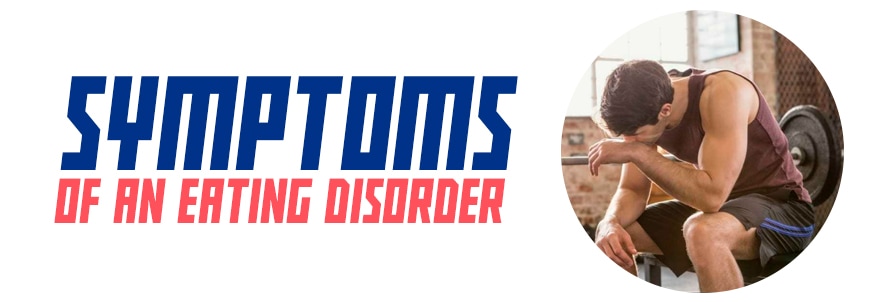RISK FACTORS FOR ATHLETES
The age group is around 15-30.According to UK Sport, the sports with the highest risk of eating disorders are:

Coaches and trainers often notice subtle changes in athletes that may indicate they are struggling with an eating disorder. It is important to identify an eating disorder early, as that is one of the best predictors of a full recovery. Some common symptoms may include:

Whilst some eating disorders can become chronic debilitating conditions many sufferers can expect to make a good functional recovery especially if problems are detected early and acted upon promptly.
An athlete who is making good progress in therapy may be in a position to resume sports participation. There is a clear parallel here with the athlete returning to sport after a serious injury. Returning to a light training load is the first step and as recovery progresses the training load increases until eventually the athlete is ready to return to competition. A graded return like this can serve as a powerful reward for making progress in therapy. As with injury rehabilitation, close cooperation between the therapist/physician and coach/athlete is essential. There are four factors to be considered when planning a rehabilitation program. In order of priority, they are medical stability (including any electrolyte abnormalities, anaemia, low bone density etc), nutritional stability (a minimum requirement is that nutrition is sufficient to maintain weight despite the increased energy expenditure), abstinence from disordered eating behaviors and consideration of the psychological stresses that may be present in the sports environment and which may contribute to a relapse of the condition. It is occasionally necessary to consider offering athletes support to leave the sports environment. It may simply be too toxic and too likely to promote relapse or the disorder itself so severe that return is inadvisable.
- Sports that emphasize appearance, weight requirements, or muscularity (gymnastics, diving, bodybuilding, or wrestling).
- Sports that focus on the individual rather than the entire team (gymnastics, running, figure skating, dance or diving, versus teams sports such as basketball or soccer).
- Endurance sports such as track and field, running, swimming.
- Overvalued belief that lower body weight will improve performance.
- Training for a sport since childhood or being an elite athlete.
- Low self-esteem; family dysfunction (including parents who live through the success of their child in sport); families with eating disorders; chronic dieting; history of physical or sexual abuse; peer, family and cultural pressures to be thin, and other traumatic life experiences.
- Coaches who focus primarily on success and performance rather than on the athlete as a whole person.
- Three risk factors are thought to particularly contribute to a female athlete’s vulnerability to developing an eating disorder: social influences emphasizing thinness, performance anxiety, and negative self-appraisal of athletic achievement. A fourth factor is identity solely based on participation in athletics.
The age group is around 15-30.According to UK Sport, the sports with the highest risk of eating disorders are:
- Swimming.
- Running.
- Gymnastics.
- Diving.
- Synchronised swimming.
- Wrestling.
- Judo.
- Lightweight rowing.
What are the symptoms of an eating disorder?

Coaches and trainers often notice subtle changes in athletes that may indicate they are struggling with an eating disorder. It is important to identify an eating disorder early, as that is one of the best predictors of a full recovery. Some common symptoms may include:
- Decreased concentration, energy, muscle function, coordination, speed
- Increased fatigue and perceived exertion
- Longer recovery time needed after workouts, games, races
- More frequent muscle strains, sprains, and/or fractures
- Slowed heart rate and low blood pressure
- Reduced body temperature and being sensitive to cold—cold hands and feet
- Complaints of light-headedness and dizziness, abdominal pain
- Poorer interaction with coaches/teammates
- Perfectionism
- Increased impatience, crankiness
- Increased isolation
- Difficulty with days off and tapering
- Avoidance of water or excessive water intake
- Preoccupation with their food
- Preoccupation with another’s food
- Ritualistic eating and/or avoidance of certain foods
- Excessive concern with body aesthetic
- Prolonged or additional training above and beyond that required for sport (e.g. extra sit-ups and laps, extra workouts)
- Athletes on the team reporting concern about an individual
Anorexia Nervosa in Athletes
Anorexia nervosa refers to behaviors of severely restricting food intake. Athletes in aesthetic sports, that is, those that emphasize body appearance, are often seen engaging in these behaviors. Signs of disordered eating and exercising that may point to anorexia nervosa are:- Fixation on body weight, shape or size.
- Calorie counting.
- Intense fear of gaining weight.
- Preoccupation on contents and nutritional aspects of food.
- Declining/skipping meals.
- Refusing to eat in front of others.
- Food rules.
- Distorted body image.
- Participation in an aesthetic sport (dance, gymnastics, figure skating, wrestling, equestrianism).
- Unusual food behaviors.
- Reported lethargy, difficulty with stamina.
- Impaired concentration.
Bulimia in Athletes
Bulimia nervosa involves individuals engaging in binge eating followed by compensatory behaviors such as purging, fasting, or excessive exercise. As noted above, this disorder is more common in athletes than anorexia nervosa as they require increased nourishment to fuel their activities yet may continue to struggle with appearance or weight due to sport requirements as well. The following may signify an athlete is engaging in bulimic behaviors:- Binge eating behaviors after practice, interrupted or followed by trips to the bathroom.
- Eating in secret.
- Hiding food.
- Preoccupation with body weight/shape/size.
- Distorted body image.
- Eating beyond fullness.
- Expressing shame or guilt around eating.
- Possessing/purchasing diuretics and/laxatives.
- Excessive coffee drinking/fluid consumption.
- Scarring on the knuckles.
Binge Eating in Athletes
Finally, Binge Eating Disorder (BED) in athletes is common, particularly if they are engaging in restrictive behaviors or simply not nourishing their bodies properly in accordance with their energy output. Be aware of the following signs of binge eating:- Eating in secret.
- Hiding food.
- Expressing shame/guilt around food and/or eating.
- Eating at a fast pace.
- Reported feelings of depression or low self-worth.
- Nourishment in public is observed to be inappropriate with the amount of energy output.
- Weight fluctuations.
- Lethargy.

Whilst some eating disorders can become chronic debilitating conditions many sufferers can expect to make a good functional recovery especially if problems are detected early and acted upon promptly.
An athlete who is making good progress in therapy may be in a position to resume sports participation. There is a clear parallel here with the athlete returning to sport after a serious injury. Returning to a light training load is the first step and as recovery progresses the training load increases until eventually the athlete is ready to return to competition. A graded return like this can serve as a powerful reward for making progress in therapy. As with injury rehabilitation, close cooperation between the therapist/physician and coach/athlete is essential. There are four factors to be considered when planning a rehabilitation program. In order of priority, they are medical stability (including any electrolyte abnormalities, anaemia, low bone density etc), nutritional stability (a minimum requirement is that nutrition is sufficient to maintain weight despite the increased energy expenditure), abstinence from disordered eating behaviors and consideration of the psychological stresses that may be present in the sports environment and which may contribute to a relapse of the condition. It is occasionally necessary to consider offering athletes support to leave the sports environment. It may simply be too toxic and too likely to promote relapse or the disorder itself so severe that return is inadvisable.

